


Delayed self-ignition
It is well-known that periodic acid is a strong oxidizer, but that it leads to self-igniting mixtures with red phosphorus is not a well-known thing. In this experiment it is shown that mixes of these two chemicals quickly ignite, even without mixing. Just sprinkling some red phosphorus over periodic acid allows ignition of the mix in seconds.

The picture shows the spraying around of fire and the pink/purple smoke, formed in the reaction.
![]()
![]() Required
chemicals:
Required
chemicals:
-
periodic acid
-
red phosphorus
![]() Required
equipment:
Required
equipment:
-
watch glass or other suitable piece of glass
![]() Safety:
Safety:
-
If performed on a very small scale, as shown in this web page, then this experiment is relatively safe as long as flammable materials are kept at least half a meter from the reaction mix. Do not scale up the experiment!
-
Periodic acid is corrosive, avoid contact with skin.
-
Red phosphorus is very flammable.
-
A small amount of smoke is produced in the experiment. It is best to do this in a well-ventilated room. As long as the minute quantities are used, as directed in this page, the amount of smoke is so small that there is no real inhalation risk. This is so, because of the relatively non-toxic nature of the smoke.
![]() Disposal:
Disposal:
-
Just rinse the (watch)glass under a running tap. No particularly toxic waste is produced in this experiment.
![]()
![]() Take a
small piece of periodic acid (at most half the size of a pea) and crunch this
into smaller pieces on a watch glass.
Take a
small piece of periodic acid (at most half the size of a pea) and crunch this
into smaller pieces on a watch glass.
![]() Allow
the acid to pickup some moisture from the air, such that it looks somewhat wet,
but it should not liquefy. If perfectly dry periodic acid is used, then it takes
more time before the self-ignition occurs. If the acid is allowed to become
really wet, then it becomes too dilute and no self-ignition will occur anymore.
Allow
the acid to pickup some moisture from the air, such that it looks somewhat wet,
but it should not liquefy. If perfectly dry periodic acid is used, then it takes
more time before the self-ignition occurs. If the acid is allowed to become
really wet, then it becomes too dilute and no self-ignition will occur anymore.
![]() Take a
very small amount of red phosphorus and make this into a fine powder by grinding
it carefully.
Take a
very small amount of red phosphorus and make this into a fine powder by grinding
it carefully.
![]() Sprinkle
the red phosphorus over the periodic acid and wait. Usually within ten seconds
the red phosphorus ignites. If the acid is very dry, then it may take a few tens
of seconds, but also then it will ignite.
Sprinkle
the red phosphorus over the periodic acid and wait. Usually within ten seconds
the red phosphorus ignites. If the acid is very dry, then it may take a few tens
of seconds, but also then it will ignite.
Below a sequence of a few images is given, showing the ignition and the spraying of burning red phosphorus.
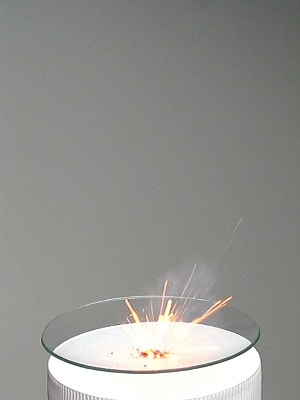
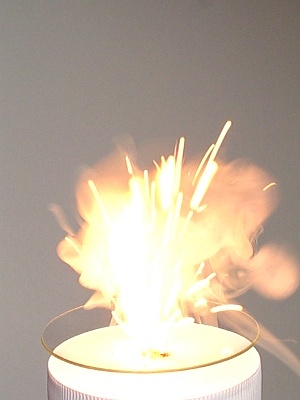
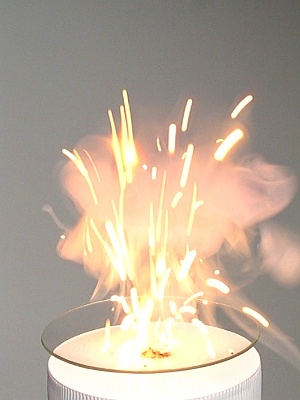
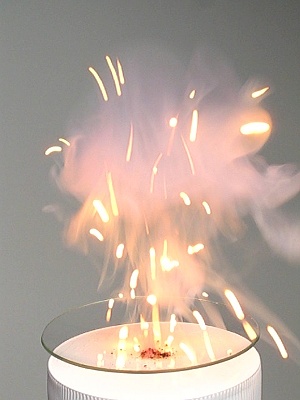
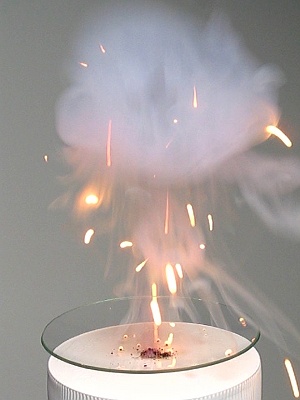
A video is made of this experiment. It can be viewed by clicking here.
![]()
Discussion of results
Periodic acid a very strong oxidizer. With red phosphorus it reacts and this reaction produces a lot of heat, so much that the mixture ignites.
Best results are obtained if the acid is slightly humid. In that case, the particles of red phosphorus become covered by acid completely and probably are immersed in it and this greatly enhances the production of heat and leads to faster ignition.
The phosphorus is oxidized to phosphorus pentoxide and the periodic acid partly is reduced to iodine (pink color of the smoke) and probably even further down to iodide.